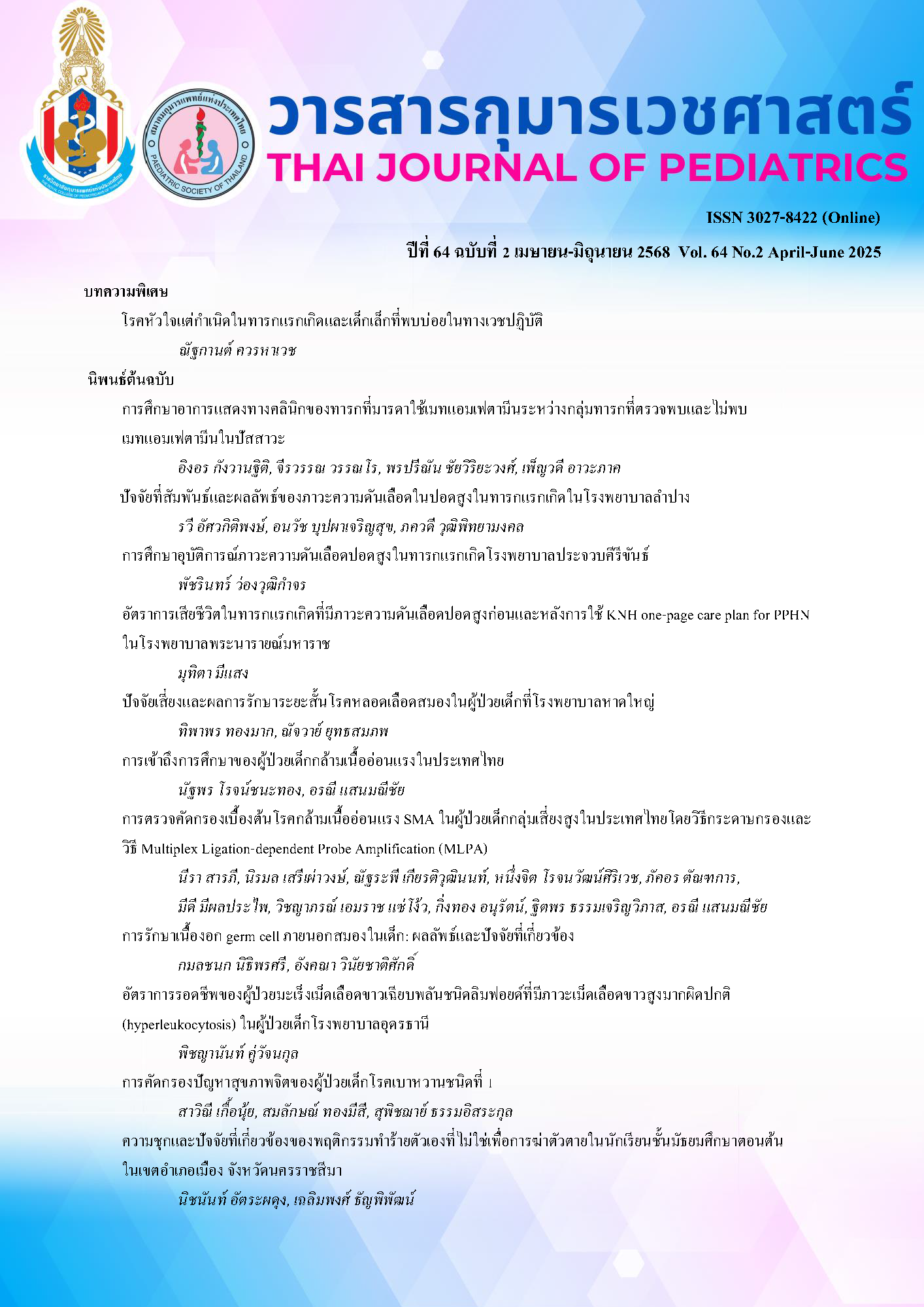A Study of clinical manifestations in infants born to mothers using methamphetamines: A descriptive study in infants with positive and negative methamphetamine urine tests
Keywords:
Methamphetamine, amphetamine, prenatal exposure, clinical manifestationsAbstract
Background: The use of methamphetamines during pregnancy has increased. Urine tests of newborns have revealed both positive and negative results for methamphetamine. However, there is limited clinical evidence regarding the differences in symptoms between the two groups of newborns.
Objective: To investigate the clinical manifestations of newborns born to mothers who used methamphetamine during the prenatal period at Hat Yai Hospital.
Methods: A retrospective study was conducted by reviewing medical records of newborns born to mothers who tested positive for methamphetamine in their urine during the prenatal period from March 1, 2021, to March 1, 2024. The symptoms and clinical outcomes of newborns with positive and negative urine methamphetamine results were evaluated. Multivariable logistic regression was used to assess the relationships between variables.
Results: A total of 319 newborns who were born to mothers with urine tested positive for methamphetamine were enrolled. Of those, 277 (86.8%) newborns had urine positive for methamphetamine and 42 (13.2%) newborns had negative results. The median maternal age was 29 years old, with 25.4% of the mothers had attended at least five antenatal visits according to the Department of Health. Severe preeclampsia and postpartum hemorrhage occurred in 16.9% and 7.2% of mothers, respectively. The median birth weight was 2,760 grams. In the positive and negative methamphetamine groups, low birth weight was observed in 20.2% and 38.1% of newborns, respectively, and the 1-minute Apgar score ≤7 in 3.2% and 11.9%, respectively. Newborns with positive urine methamphetamine had a significantly lower likelihood of preterm birth (adjusted odds ratio [aOR] 0.43; 95% confidence interval [CI], 0.21- 0.86), respiratory distress (aOR 0.46; 95% CI 0.23-0.91), hypoglycemia (aOR 0.28; 95% CI 0.08-0.96), admission to neonatal intensive or intermediate care (aOR 0.43; 95% CI 0.21-0.86), jaundice (aOR 0.17; 95% CI 0.03-0.95) and significant higher likelihood elevated body temperature (aOR 1.8; 95% CI 1.04-3.11) than those in the negative group.
Conclusion: This study found that the detection of methamphetamine in the urine of infants born to mothers who used methamphetamine during prenatal period was not correlated with the infants’ clinical manifestations. Therefore, it is recommended to monitor the newborn closely and perform urine testing when clinically indicated to assist in diagnosis and management, such as withdrawal symptoms or seizures.
Downloads
References
United Nations Office on Drugs and Crime. World Drug Report 2022: Special Points [Internet]. United Nations publication; 2022 [cited 2025 May 26]. Available from: https://www.unodc.org/res/wdr2022/MS/WDR22_Special_Points.pdf
สำนักงานคณะกรรมการป้องกันและปราบปรามยาเสพติด. ผลการดำเนินการปราบปรามยาเสพติดทั่วประเทศปี 2564 [Internet].[กรุงเทพฯ]: สำนักงานคณะกรรมการป้องกันและปราบปรามยาเสพติด; 2564 [cited 2025 May 26]. Available from: https://www2.oncb.go.th/DocLib/ผลการปราบปรามยาเสพติดทั่วประเทศ%20ปี%202564.pdf
Tavella RA, DE Abreu VOM, Muccillo-Baisch AL, DA Silva Júnior FMR. Prevalence of illicit drug use during pregnancy: A global perspective. Anais Acad Bras Cienc. 2020;92: Available from: https://doi.org/10.1590/0001-3765202020200302
Thaithumyanon P, Limpongsanuruk S, Praisuwanna P, Punnahitanon S. Impact of prenatal illicit drug expose on mother and infant. Chulalongkorn medical journal. 2004;48: 235-45.
ทิพย์อุษา จันทร์ทองศรี. ผลกระทบจากการเสพสารเมทแอมเฟตามีนของมารดาขณะตั้งครรภ์ต่อทารกในระยะแรกเกิด โรงพยาบาลเซกา จังหวัดบึงกาฬ[Internet]. Sakon Nakhon provincial public health office open access; 2566 [cited 2025 May 26]; Available from: https://skko.moph.go.th/dward/document_file/oa/research_file_name/20230717133205_976338236.pdf
นทสรวง ชาวปรางค์. ผลกระทบต่อทารกจากมารดาที่ใช้สารแอมเฟตามีนระหว่างการตั้งครรภ์และปัจจัยที่มีผลต่อความรุนแรงของอาการถอนยาในทารก. Chiang Rai Journal. 2022;14:118-30.
Kemper AR, Newman TB, Slaughter JL, Maisels MJ, Watchko JF, Downs SM, et.al. Clinical Practice Guideline Revision: Management of Hyperbilirubinemia in the Newborn Infant 35 or More Weeks of Gestation. Pediatrics. 2022 Aug;150(3):e2022058859.
Oral R, Strang T. Neonatal illicit drug screening practices in Iowa: The impact of utilization of a structured screening protocol. J Perinatol. 2006;26:660-6.
ระบบคลังข้อมูลด้านการแพทย์และสุขภาพ (HDC) สำนักงานสาธารณสุขจังหวัดสงขลา เขตสุขภาพที่ 12.อนามัยแม่และเด็ก [Internet]. [cited 2025 May 26].Available from: https://hdc.moph.go.th/ska/public/standard-subcatalog/1ed90bc32310b503b7ca9b32af425ae5
อดิศักดิ์ ไวเขตการณ์. ผลลัพธ์การตั้งครรภ์ของมารดาและทารกในสตรีตั้งครรภ์ที่เสพสารเมทแอมเฟตามีนระหว่างตั้งครรภ์. วารสารโรงพยาบาลมหาสารคาม. 2021;18:105-11.
Gorman MC, Orme KS, Nguyen NT, Kent EJ, Caughey AB. Outcomes in pregnancies complicated by methamphetamine use. Am J Obstet Gynecol. 2014;211:429.e1-7.
Oei JL, Kingsbury A, Dhawan A, Burns L, Feller JM, Clews S, et al. Amphetamines, the pregnant woman and her children: A review. J Perinatol. 2012;32:737-47.
Wright TE, Schuetter R, Tellei J, Sauvage L. Methamphetamines and pregnancy outcomes. J Addict Med. 2015;9:111-7.
Smith L, Yonekura ML, Wallace T, Berman N, Kuo J, Berkowitz C. Effects of prenatal methamphetamine exposure on fetal growth and drug withdrawal symptoms in infants born at term. J Dev Behav Pediatr. 2003;24:17-23.
Harst L, Deckert S, Haarig F, Reichert J, Dinger J, Hellmund P, et al. Prenatal methamphetamine exposure: Effects on child development –a systematic review. Dtsch Arztebl Int. 2021;118:313-9.
Chomchai C, Na Manorom N, Watanarungsan P, Yossuck P, Chomchai S. Methamphetamine abuse during pregnancy and its health impact on neonates born at Siriraj hospital, Bangkok, Thailand. Southeast Asian J Trop Med Public Health. 2004;35:228-31.
Sankaran D, Lakshminrusimha S, Manja V. Methamphetamine: Burden, mechanism and impact on pregnancy, the fetus, and newborn J Perinatol. 2022;42:293-9.
Doi M, Nakama N, Sumi T, Usui N, Shimada S. Prenatal methamphetamine exposure causes dysfunction in glucose metabolism and low birthweight. Front Endocrinol (Lausanne). 2022;13:1023984.
ชลธิรา ชุ่มมณี. การพยาบาลทารกแรกเกิดที่มารดาเสพสารเสพติดแอมเฟตามีน โรงพยาบาลนามน จังหวัดกาฬสินธุ์: กรณีศึกษา. Journal of Environmental Health and Community Health. 2024;9:718-24.
สายชล ขุนหล้า. การพยาบาลทารกแรกเกิดที่มารดาเสพสารเสพติดแอมเฟตามีน: กรณีศึกษา. Journal of Environmental Health and Community Health. 2023;8:670-6.
Krekels EHJ, Rower JE, Constance JE, Knibbe CAJ, Sherwin CMT. Hepatic drug metabolism in pediatric patients. In: Xie W. Drug metabolism in disease. Academic press; 2017.p. 181-206.
de la Torre R, Yubero-Lahoz S, Pardo-Lozano R, Farré M. MDMA, methamphetamine, and CYP2D6 pharmacogenetics: What is clinically relevant?. Front Genet. 2012;3:235.
Cruickshank CC, Dyer KR. A review of the clinical pharmacology of methamphetamine. Addiction. 2009;104:1085-99.
Downloads
Published
How to Cite
Issue
Section
License
Copyright (c) 2025 The Royal College of Pediatricians Of Thailand

This work is licensed under a Creative Commons Attribution-NonCommercial-NoDerivatives 4.0 International License.


